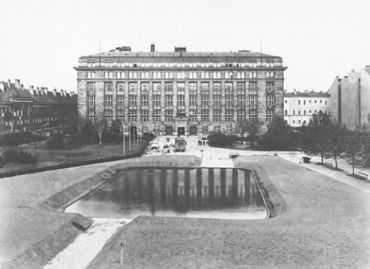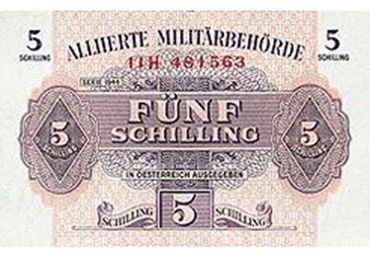1938–1945
1816 – 1818 | 1818 – 1878 | 1878 – 1922 | 1922 – 1938 | 1938 – 1945 | 1945 – 1998 | seit 1999 |
The central bank during the Third Reich
The Anschluss

After the end of World War I, efforts to return to peaceful coexistence in Austria were doomed. Political camps formed in all areas, all of which sought to advance their own interests, if necessary by fraudulent means, coercion or even with armed force. As the corporatist Ständestaat was ruled by an authoritarian government and as it had banned the Social Democratic Party, it was isolated in domestic and foreign affairs. Thus weakened, the Austrian government could not muster the power necessary to repudiate the efforts of the National Socialist Third Reich to annex Austria.
The National Socialists seized power in March 1938, leading to a spate of arrests, abductions and suicides of Austrian politicians, artists and intellectuals, above all, Jewish Austrians. Sigmund Freud, for example, emigrated against the background of the looming threat.
When Austria became part of the Third Reich through the Anschluss, the OeNB became part of the Deutsche Reichsbank: Just a few days after the invasion of German troops in Vienna, a German law ordered the liquidation of the Oesterreichische Nationalbank. The entire gold holdings and foreign currency reserves of the OeNB were transferred to Berlin. (After World War II, 50,182 kilograms of the total of 78,267 kilograms of gold valued at 470 million Austrian schillings in 1938 were returned to the OeNB.) The remainder, Austria’s share of 102,108,516.42 Austrian schillings in the Tripartite Gold Commission’s Gold Pool (so-called “monetary gold”), was granted to the International Fund for the Victims of National Socialism in 1998.)
Reichsbank officials took over all power at the Vienna Reichsbank head office and at all other Reichsbank offices located throughout the annexed Austrian territory. Within a very short time, all officials, employees and workers of the institution who seemed suspicious to the new powers were dismissed, sent into retirement or arrested.
Immediately after the occupation of the Austrian territory, the monetary system was also incorporated into the Third Reich: On March 17, 1938, the Reichsmark was introduced in Austria by decree. The exchange rate was set at 1.5 Austrian schillings to the Reichsmark.
Irretrievable losses

The war triggered by Germany’s invasion of Poland in 1939 burgeoned into World War II in the next few years and rapidly put an enormous strain on all of society.
Many central bank employees were drafted onto the German army. Those who returned in 1945 were confronted with the legacy of the war: Hundreds of thousands of people had been killed during World War II. Production plants and residential areas had been laid waste. The Austrian economy had been severely handicapped. After the war, Austria’s productive capacity had fallen to just over 40% of the 1937 level.
The National Socialists had pumped up money supply enormously to finance the war. According to contemporary estimates, the amount of money in circulation required to preserve price stability should not have exceeded half a billion Reichsmark at the end of 1946. In actual fact, at the end of World War II, some 11 billion Reichsmark were estimated to be in circulation. In addition, the Allies issued paper money: All in all, some 10 billion Allied military schillings were printed.
Reichsbank offices from 1938 to 1945 in focus: the Vienna Reichsbank head office
The OeNB commissioned a team of historians led by Oliver Rathkolb and Theodor Venus to research the history of the OeNB in the years leading up to Austria’s Anschluss in 1938 and under the National Socialist regime. The team’s findings have been published in German with an English summary.
